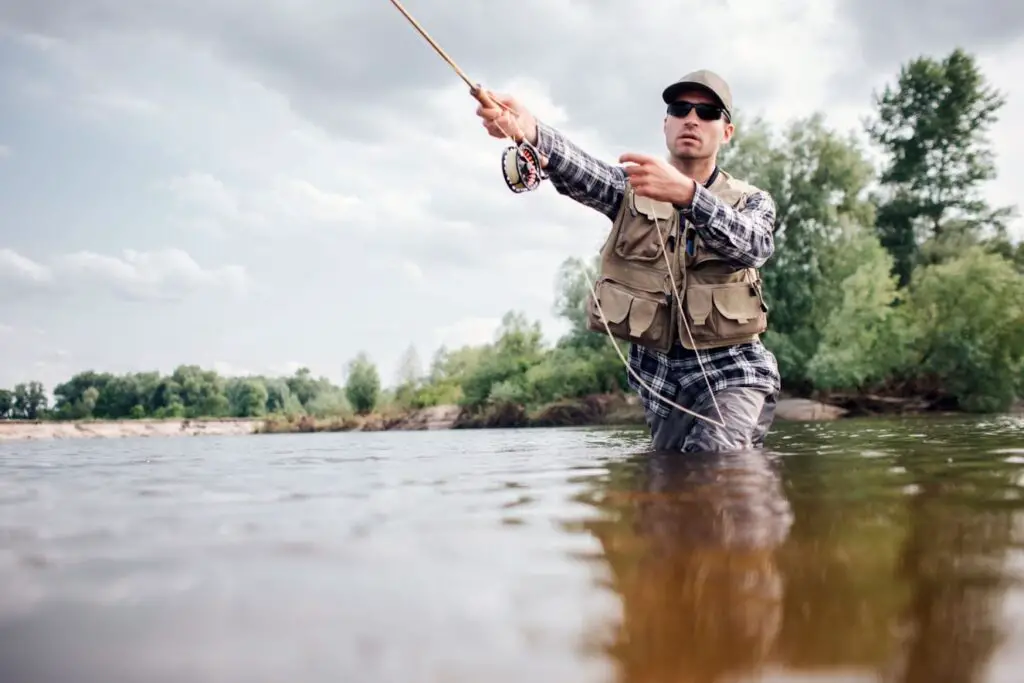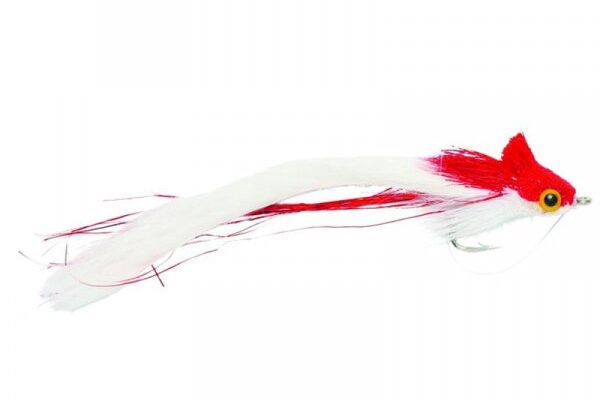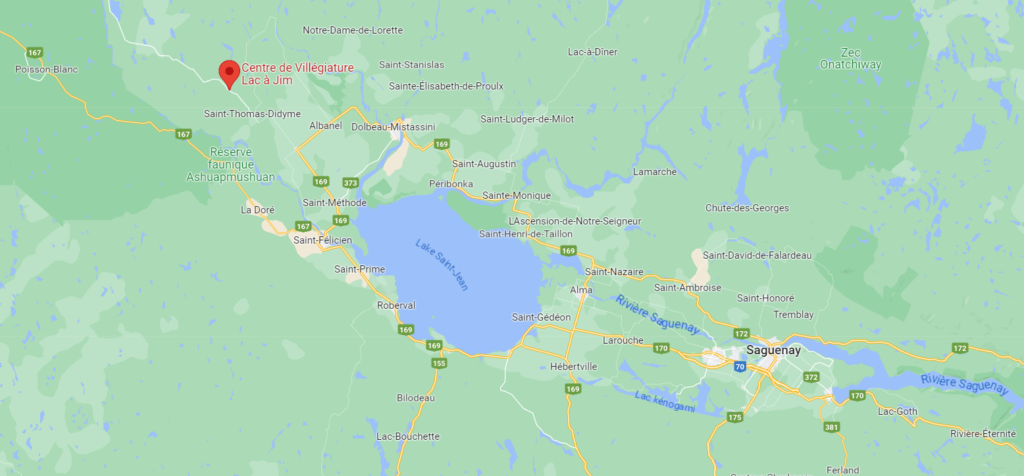Landlocked salmon, an Atlantic salmon that lives in freshwater lakes, is highly prized by anglers and is mainly found in the Saguenay-Lac-Saint-Jean and Outaouais regions.
In other regions, such as Mauricie, landlocked salmon are thought to have been introduced during the era of private fishing clubs.
Landlocked salmon fishing is available by wading and boat in Lac Saint-Jean, but also by fly fishing in the river, where this activity is subject to quotas.
A summary of Ouananiche
Ouananiche feeding
Its diet consists mainly of small fish, especially rainbow smelts.
It also feeds on insects and other aquatic invertebrates.
The feeding habits of landlocked salmon have been studied in depth. It was found that their diet can vary according to the availability of food sources.
The landlocked salmon population declined in the early 2000s due to a decrease in the abundance of rainbow smelt, resulting in a change in feeding habits.
Following the implementation of a restoration plan based on strict regulatory measures and an intensive restocking program, there has been a substantial improvement in the landlocked salmon situation. Particularly in the Lac Saint-Jean region of Quebec.
Where do landlocked salmon live?
It prefers cold, well-oxygenated waters, and is often found in the rivers and streams that flow into these lakes.
Landlocked salmon need suitable breeding habitat to survive, and generally use rivers for spawning.
These waterways are fishing sanctuaries, where fishing is not permitted to protect landlocked salmon and their spawning habitat.
Maintaining water quality and habitat management are essential to the survival of landlocked salmon and the sustainability of their population.
Development projects are regularly carried out to improve landlocked salmon breeding habitat, notably by building tributaries to provide optimal spawning conditions.
Landlocked salmon distribution in Quebec
Here is an overview provided by Quebec government indicating areas where landlocked salmon are present.
The History of Ouananiche Fishing
Over the years, the landlocked salmon fishing has become a popular activity in Québec, particularly in the Lac Saint-Jean.
This fishing practice has developed thanks to the abundant presence of this fish. This is mainly due to its dynamic, battle-hardened nature, which makes it a real challenge for anglers.
Landlocked salmon fishing has become a tourist phenomenon in France. Lac Saint-Jeansince the 1880s, thanks to American businessman Horace Jansen Beemer.
The latter has recognized the tourism potential of this fishing activity, transforming the region’s image and contributing to its economic development.
Over the following decades, the popularity of landlocked salmon fishing has waxed and waned, depending on the abundance of this fish in the region. Lac-Saint-Jean.
Today, in order to preserve this heritage, the Ministère des Forêts, de la Faune et des Parcs (Ministry of Forests, Wildlife and Parks) is striving to maintain appropriate management measures aimed at ensuring the long-term survival of this species and the quality of its habitat.
Fishing Techniques
Lures for landlocked salmon
To increase your chances of success, it is essential to choose the right lures.
Whether you prefer spoons, crankbait fishWhether it’s a fly or a leader technique, there’s a wide range to consider. Here are a few recommendations:
Lures and baits recommended for landlocked salmon fishing :
- Earthworms : Used in a dead line, they are effective at depth.
- Spoons :
- Dartee blue
- Sutton 44
- Mooselook
- K-7
- A-48
- Dardevil hammered blue and silver
- Little Cleo (blue or orange)

- Swimming fish :
- Rapala j9 articulated (especially in black)
- Yozuri (silver and purple)
- Tasmanian devil (silver-blue)

- Other lures :
- Toronto wobbler
- Magog fly smelt tendem
- Line technique A spoon followed by a 24-36 inch leader, with a very small hook tipped with a large worm.
Equipped with these lures, you’ll be ready for a memorable fishing experience in search of landlocked salmon.
Fly-fishing for landlocked salmon

Fly-fishing is a popular technique for catching landlocked salmon.
It is preferable to fish with a fly rod and a setting line with a streamer, tandem or tube fly.
To optimize your chances of success, it’s important to choose the right fly for the conditions you’ll encounter on your fishing trip.
Flies of various colors and shapes can be used to imitate landlocked salmon’s natural prey, attracting them to your hook.
On specialist forums, many people share their favourite flies for this beautiful catch.
Among the flies most recommended for landlocked salmon are theAllan Street Hookerthe Grey Ghost and the White Rabbit Strip.

Classics such as Colonel Bates also remain a preferred choice for many anglers.
Nymphs are not left out, with effective options such as the Hares Hare and the Casual Dress.
Finally, the Muddler Marabou in shrimp or reddish-brown also stands out.
These recommendations are the fruit of many experiences and exchanges between enthusiasts, and offer a good starting point for those seeking to optimize their selection of flies for landlocked salmon.
Troll fishing
Trolling is another common method of catching landlocked salmon.
This technique involves dragging a lure or fly behind a moving boat at a relatively slow speed.
Trolling can be very effective for locating landlocked salmon in lakes, especially when they are scattered or far from spawning grounds.
When trolling, it’s important to use a lure adapted to the speed of the boat, as speed influences the depth at which the lure will be presented.
Wobbling spoons and certain types of flies are particularly effective for this method of fishing.
Depth and Speed
To succeed in landlocked salmon fishing, it is important to master certain aspects such as depth and speed.
Landlocked salmon are generally found at a depth of around 12 feet (3.6 m) at the start of the season when the water is cold, moving to greater depths as the water warms.
When trolling, keep a distance of about 90 feet (27.4 m) between you and the bait.
Travel speed should vary between 3 and 5 km/h at the start of the season, and should be adjusted according to water depth.
It’s important to slow down when the water is cold and landlocked salmon are less active.
To choose the right streamer, consider the depth at which you’re fishing. Dark colors generally work best at depth, while bright colors work best when you’re fishing landlocked salmon on the surface.
And don’t hesitate to vary your boat speed from 1.5 to 3-4 km/h to test different lures and find the one that attracts the most fish.
In July and August, when the lake is warmer, landlocked salmon are fished offshore between two waters.
Use a downrigger and sonar to find good fishing spots. At this time of year, look for schools of smelt, because where there are smelt, there are often landlocked salmon.
By keeping these tips in mind and adapting your speed and depth to the fishing conditions, you’ll increase your chances of catching landlocked salmon.
Rules and regulations
Socket limit
The daily catch limit for landlocked salmon varies from region to region. According to the Ministère des Forêts, de la Faune et des Parcs du Québec, this limit can be from one to four specimens.
For example, in some CFA waters, the limit has been lowered, except in one fly-fishing sector of the Métabetchouane River, where the limit is one landlocked salmon.
Fishing season
The landlocked salmon fishing season generally begins on May 15 and ends on a fixed date, depending on the region.
For Lac-Saint-Jean, Lac à Jim and Rivière Ouiatchouan, fishing opens on May 15.
Note that certain zones may be prohibited, such as zone 21, where landlocked salmon fishing is forbidden except at the mouth of the Rivière aux Outardes on the Côte-Nord and in a section of the Rivière Saguenay.
Obtaining a permit
To fish for landlocked salmon, you need a regular fishing permit issued by the Ministère des Forêts, de la Faune et des Parcs du Québec.
This permit is valid for the current fishing season.
Consult the sport fishing regulations for precise rules and dates depending on the region where you wish to practice this activity.
Complementary species for landlocked fishing
When fishing for landlocked salmon, it is also possible to come across other species of fish. fish species in the same habitat.
These complementary species include walleye, smelt, rainbow smelt and Atlantic salmon.
Visit gold is a popular species among fishermen for its tasty flesh. Walleye are often found in areas where landlocked salmon are also found. Trolling and using swimmers are effective techniques for catching this species.
L’smelt is another species you may encounter while landlocked fishing. Smelts are small, silvery fish usually found in schools. They are a source of food for landlocked salmon and Atlantic salmon, among others. To catch them, you can use nets, light casts or spoons.
Visit rainbow smelts are also found in the same waters as landlocked salmon. They are distinguished by their bright colors and dorsal fin. You can fish for them using techniques similar to those used for ordinary smelt.
Finally, the Atlantic salmon is another emblematic species you’ll come across when fishing for landlocked salmon. This fish is prized for its delicate flesh and can be caught using flies, lures or swimmers.
By targeting these complementary species, you’ll increase your chances of success and diversify your landlocked salmon catch.
Fishing spots
Lakes
Landlocked salmon fishing is particularly popular in certain Quebec lakes. Among the best known are Lac Saint-Jean and Lac à Jim.
These lakes are located in freshwater regions ideal for landlocked salmon. The Saguenay-Lac-Saint-Jean and Outaouais regions are also ideal for landlocked salmon.
- Lac Saint-Jean The lake is very popular for landlocked salmon fishing. Anglers can use several techniques to catch this fish, including wading and boat fishing.
- Jim’s Lake Lac à Jim: Located near Réserve faunique Ashuapmushuan, Lac à Jim is another ideal spot for landlocked salmon fishing.
Rivers
Cold, oxygenated rivers are also ideal for landlocked salmon fishing. Here are some of the best-known rivers for this activity:
- Ashuapmushuan River : Quota fly-fishing is permitted in certain sectors and during certain specific periods.
- Métabetchouane River This river is an excellent place to fish for landlocked salmon.
- Mistassini River The landlocked salmon fly-fishing industry is also subject to quotas.
- Rivière aux Saumons Ashuapmushuan: As in Ashuapmushuan, fly-fishing is subject to quotas.
- Mistassibi River The lake is also a good choice for landlocked salmon fishing.
- Péribonka River The St. Lawrence River: With its cold, oxygenated waters, it offers ideal conditions for landlocked salmon fishing.
Frequently asked questions
What is the maximum length for landlocked salmon?
Permitted length for landlocked salmon varies according to the fishing regulations of each region. Before going fishing, consult the local regulations to find out the minimum size allowed in the zone of your choice.
Where can you fish for landlocked salmon in Kiamika?
To fish for landlocked salmon in Kiamika, look for areas where the fish are frequently present, such as nearby lakes and rivers. Be sure to consult local fishing and water information to find the best spots.
Which lures to use for landlocked salmon in spring?
In spring, landlocked salmon are more active, making lures more effective. Use flies, spoons or swimbaits that imitate the purple fish landlocked salmon eat during this period.
How do you know the ideal temperature for landlocked salmon fishing?
The ideal temperature for landlocked salmon fishing can vary according to local and seasonal conditions. Generally speaking, the best temperatures are between 10 and 15°C. Keep an eye on weather and water temperatures to maximize your chances of success.








